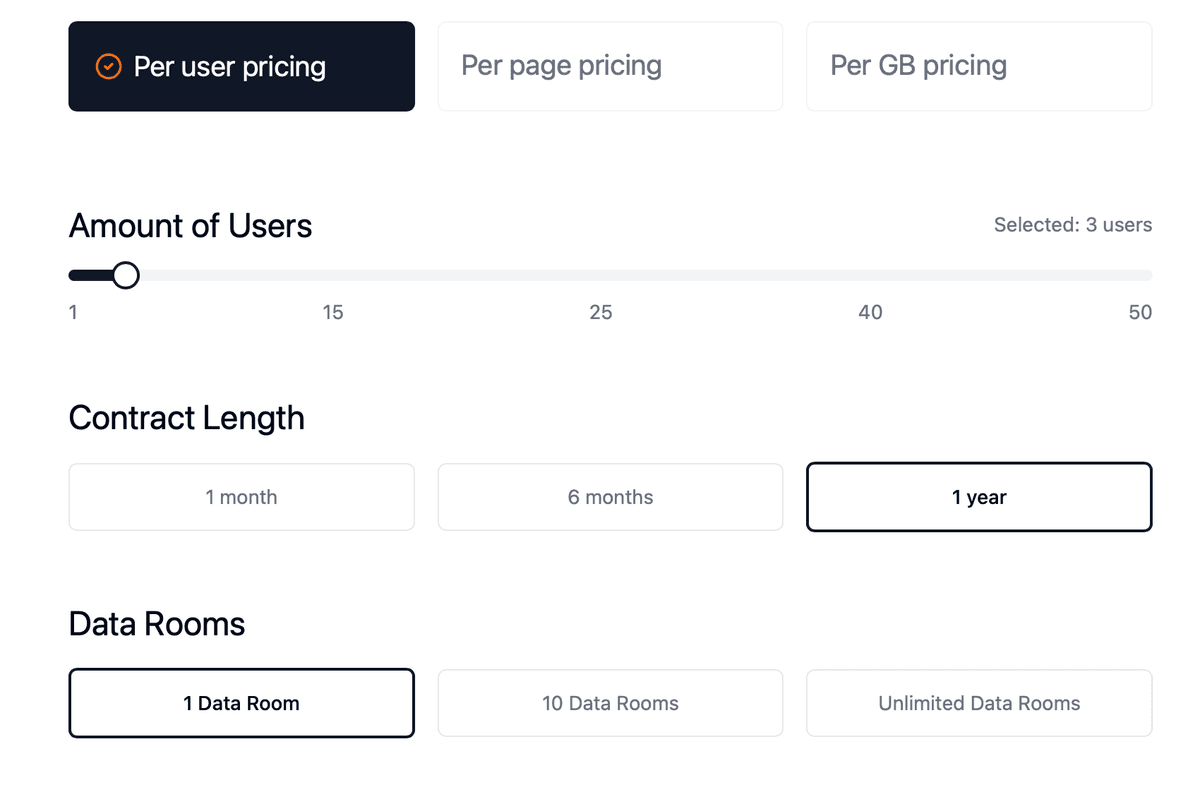How much does Due Diligence Cost in 2025?
Due Diligence Costs in 2025
In today's fast-paced business environment, due diligence has become an essential component of any significant business transaction, from mergers and acquisitions to investment decisions. However, the costs associated with due diligence can vary widely depending on the scope, complexity, and type of transaction. Understanding these costs is crucial for businesses to budget effectively and make informed decisions.
In this comprehensive guide, we'll explore the various factors that influence due diligence costs, break down the typical expenses, and provide insights into how to optimize your due diligence budget in 2025.
Quick recap of due diligence costs
- M&A Due Diligence Costs
- Investment Due Diligence Costs
- Legal Due Diligence Costs
- Financial Due Diligence Costs
- Operational Due Diligence Costs
- IT Due Diligence Costs
- Environmental Due Diligence Costs
- HR Due Diligence Costs
Looking to streamline your due diligence process? Learn about virtual data rooms for due diligence

Types of Due Diligence and Their Costs
Due diligence costs can vary significantly based on the type and scope of the investigation. Here's a breakdown of the main types of due diligence and their associated costs:
1. M&A Due Diligence Costs
M&A due diligence is typically the most comprehensive and expensive type, as it involves multiple aspects of the target company.
- Small Deals (less than $10M): $25,000 - $50,000
- Mid-Sized Deals ($10M - $100M): $50,000 - $150,000
- Large Deals (more than $100M): $150,000 - $500,000+
Factors affecting costs:
- Deal size and complexity
- Industry sector
- Geographic scope
- Number of target companies
- Timeframe for completion
2. Investment Due Diligence Costs
Investment due diligence focuses on evaluating potential investment opportunities.
- Early-Stage Startups: $10,000 - $25,000
- Growth-Stage Companies: $25,000 - $75,000
- Late-Stage/Pre-IPO: $75,000 - $200,000
Key cost drivers:
- Company size and stage
- Investment amount
- Industry complexity
- Required depth of analysis
3. Legal Due Diligence Costs
Legal due diligence examines contracts, compliance, and potential legal risks.
- Small Companies: $15,000 - $30,000
- Mid-Sized Companies: $30,000 - $75,000
- Large Companies: $75,000 - $200,000
Cost factors:
- Number of contracts to review
- Regulatory compliance requirements
- Litigation history
- Intellectual property portfolio
4. Financial Due Diligence Costs
Financial due diligence analyzes the target's financial health and performance.
- Small Companies: $20,000 - $40,000
- Mid-Sized Companies: $40,000 - $100,000
- Large Companies: $100,000 - $300,000
Influencing factors:
- Financial complexity
- Number of subsidiaries
- Accounting standards
- Quality of financial records
5. Operational Due Diligence Costs
Operational due diligence evaluates business processes and efficiency.
- Small Companies: $15,000 - $30,000
- Mid-Sized Companies: $30,000 - $75,000
- Large Companies: $75,000 - $200,000
Cost considerations:
- Operational complexity
- Geographic spread
- Supply chain complexity
- Technology infrastructure
Real-World Example: How Family Offices Manage Due Diligence Costs
See how G.P. Loree & Co., a New York-based family office, uses Papermark to efficiently manage institutional investment due diligence while controlling costs:
Factors Affecting Due Diligence Costs
Several key factors can significantly impact the overall cost of due diligence:
1. Transaction Size and Complexity
Larger and more complex transactions typically require more extensive due diligence, leading to higher costs. This includes:
- Number of business units
- Geographic locations
- Regulatory requirements
- Industry complexity
2. Timeframe
The duration of the due diligence process can affect costs:
- Standard timeframe (4-8 weeks): Base cost
- Accelerated timeframe (2-4 weeks): 20-40% premium
- Extended timeframe (more than 8 weeks): Additional costs for ongoing work
3. Industry-Specific Requirements
Different industries have unique due diligence requirements:
- Healthcare: Regulatory compliance, HIPAA
- Technology: IP portfolio, cybersecurity
- Manufacturing: Supply chain, environmental
- Financial Services: Regulatory compliance, risk management
4. Quality of Available Information
The state of the target company's documentation affects costs:
- Well-organized records: Lower costs
- Disorganized or incomplete records: Higher costs
- Missing documentation: Additional investigation costs
5. Professional Service Providers
The choice of service providers impacts costs:
- Big Four accounting firms: Premium pricing
- Mid-sized firms: Competitive pricing
- Boutique firms: Specialized but potentially higher costs
- In-house teams: Lower direct costs but opportunity costs
Cost-Saving Strategies for Due Diligence
While due diligence is a necessary expense, there are several strategies to optimize costs:
1. Use Virtual Data Rooms
Virtual data rooms (VDRs) can significantly reduce costs by:
- Streamlining document sharing
- Reducing physical meetings
- Automating document tracking
- Improving collaboration efficiency
Papermark's data room solution offers an affordable option starting at $59/month.
2. Prioritize Key Areas
Focus resources on the most critical aspects:
- Identify deal-breakers early
- Concentrate on high-risk areas
- Use risk-based approach to scope
3. Leverage Technology
Utilize technology to improve efficiency:
- AI-powered document review
- Automated compliance checks
- Digital workflow management
- Analytics and reporting tools
4. Optimize Team Structure
Efficient team organization can reduce costs:
- Right-size the team
- Use specialists only when needed
- Leverage junior staff for routine tasks
- Maintain clear communication channels
5. Standardize Processes
Standardization can improve efficiency:
- Use standardized checklists
- Implement consistent reporting
- Create reusable templates
- Develop best practices
Due Diligence Cost Calculator
To help estimate your due diligence costs, consider these key variables:
- Transaction Size
- Industry Complexity
- Geographic Scope
- Timeframe
- Required Specialists
- Technology Needs

Conclusion
Due diligence costs in 2025 can vary significantly based on multiple factors, from transaction size to industry requirements. While these costs are necessary for making informed business decisions, there are strategies to optimize and manage them effectively. By leveraging technology, particularly virtual data rooms, and implementing efficient processes, businesses can conduct thorough due diligence while controlling costs.
Remember that while cost is an important consideration, the quality and thoroughness of due diligence should not be compromised, as it can prevent costly mistakes and ensure successful transactions.
